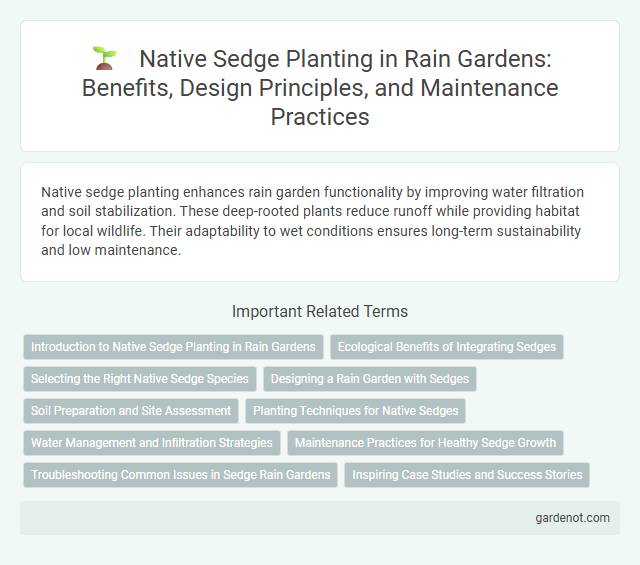Native sedge planting enhances rain garden functionality by improving water filtration and soil stabilization. These deep-rooted plants reduce runoff while providing habitat for local wildlife. Their adaptability to wet conditions ensures long-term sustainability and low maintenance.
Introduction to Native Sedge Planting in Rain Gardens
Native sedge planting in rain gardens enhances stormwater management by improving soil infiltration and reducing runoff. These resilient, deep-rooted plants stabilize soil, filter pollutants, and provide essential habitat for local wildlife. Selecting region-specific sedge species optimizes ecological benefits and supports sustainable garden ecosystems.
Ecological Benefits of Integrating Sedges
Native sedge planting in rain gardens enhances water filtration by stabilizing soil and reducing runoff, which supports cleaner local waterways. These sedges provide essential habitats and food sources for pollinators and aquatic wildlife, promoting biodiversity within urban ecosystems. Their deep root systems improve soil aeration and increase groundwater recharge, making them vital for sustainable rain garden performance.
Selecting the Right Native Sedge Species
Selecting the right native sedge species for a rain garden ensures optimal water absorption and native wildlife support. Carex species such as Carex vulpinoidea and Carex stipata thrive in moist, well-drained soils commonly found in rain gardens. Prioritize sedges that adapt to local climate conditions and seasonal water fluctuations to enhance sustainability and ecosystem resilience.
Designing a Rain Garden with Sedges
Native sedge planting in rain garden design enhances water filtration and erosion control through deep root systems that stabilize soil and improve infiltration rates. Selecting diverse sedge species adapted to local hydrological conditions maximizes ecological benefits by supporting pollinators and native wildlife while reducing maintenance needs. Incorporating sedges with varying heights and textures creates layered vegetation that optimizes stormwater absorption and aesthetic appeal in sustainable rain garden landscapes.
Soil Preparation and Site Assessment
Native sedge planting in rain gardens requires thorough soil preparation and site assessment to ensure optimal growth and water absorption. Analyze soil texture, drainage capacity, and existing vegetation to confirm suitability for sedge species, which prefer well-drained, moist soils. Conduct site grading to prevent water pooling and enrich soil with organic matter to enhance nutrient availability and soil structure for native sedge establishment.
Planting Techniques for Native Sedges
Plant native sedges by selecting moist, well-drained soil in rain gardens to mimic their natural wetland habitat. Space plugs or clumps 12-18 inches apart to allow for growth and airflow, and plant at the same depth as in the nursery container to prevent root rot. Incorporate organic mulch around the base to retain moisture and suppress weeds, ensuring healthy establishment and water filtration efficiency.
Water Management and Infiltration Strategies
Native sedge planting enhances rain garden water management by improving soil infiltration rates and reducing surface runoff. Their dense root systems create porous soil structures that increase water absorption and promote groundwater recharge. Selecting region-specific sedge species optimizes stormwater retention and supports natural hydrological cycles.
Maintenance Practices for Healthy Sedge Growth
Native sedge planting in rain gardens requires consistent maintenance practices such as regular mulching to retain soil moisture and suppress weeds. Periodic pruning of dead or damaged foliage enhances airflow and promotes vigorous sedge growth. Monitoring soil moisture levels and avoiding overwatering prevents root rot and ensures the sedges thrive in their natural wetland habitat.
Troubleshooting Common Issues in Sedge Rain Gardens
Native sedge planting in rain gardens often faces challenges such as poor drainage and soil compaction, which can lead to root rot and stunted growth. Ensuring well-drained, loamy soil with adequate organic matter improves sedge health and reduces waterlogging problems. Regular monitoring and adjusting irrigation practices helps prevent fungal diseases and promotes vigorous native sedge establishment in rain garden ecosystems.
Inspiring Case Studies and Success Stories
Native sedge planting in rain gardens has proven highly effective in enhancing stormwater management by improving soil infiltration and reducing runoff. Case studies from the Midwest reveal significant biodiversity gains and resilience in urban green spaces after incorporating sedges such as Carex vulpinoidea and Carex stipata. Success stories emphasize not only ecological benefits but also increased community engagement through educational programs centered on native sedge ecosystems.
Native sedge planting Infographic

 gardenot.com
gardenot.com